Remove the inside handle cover (A).
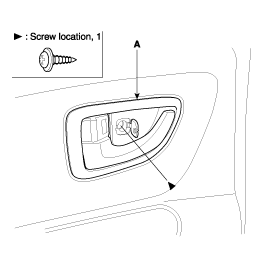
Take care not to scratch the door trim and other parts.
Put on gloves to protect your hands.
Remove the quadrant inner cover (see page BD- 57).
Remove the inside handle cover (A).

Loosen the door trim (A) mounting screws. Release the clips that hold the door trim, then remove the door trim by pulling it upward. Disconnect the power window switch connector (B), power mirror connector (C), and door courtesy lamp connector (D).

Remove the door trim seal.
Installation is the reverse of removal.
Make sure the connectors is plugged in properly and each rod is connected securely.
Make sure the door locks and opens properly.
Put on gloves to protect your hands.
Remove the door trim (see page BD- 25).
Carefully move the glass (A) until you can see the bolts, then loosen them. Separate the glass from the glass run and carefully pull the glass out through the window slot (B).
Take care not to drop the glass and scratch the glass surface.
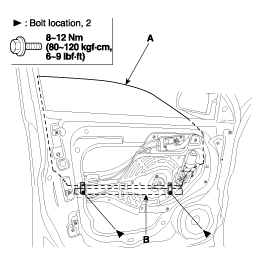
Installation is the reverse of removal.
Roll the glass up and down to see if it moves freely without binding.
Make sure that there is no clearance between the glass and glass run channel when the glass is closed.
Adjust the position of the glass as necessary (see page BD- 32).
Remove the door trim (see page BD- 25).
Remove the glass (see page BD- 26).
Loosen the rear channel mounting nuts.
After disconnecting the glass molding, remove the rear channel (A).

Installation is the reverse of removal.
Remove the door trim (see page BD- 25).
After disconnecting the connector (A), remove the power window motor (B).

Installation is the reverse of removal.
Roll the glass up and down to see if it moves freely without binding.
Put on gloves to protect your hands.
Remove the front door trim (See page BD- 25).
Remove the glass (see page BD- 26).
Disconnect the wiring harness (A).
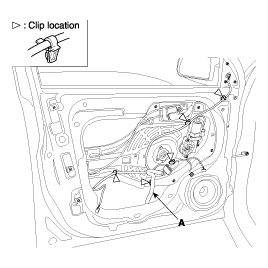
Disconnect the lock rod (A) and outside handle rod (B).
Remove the door module (C).
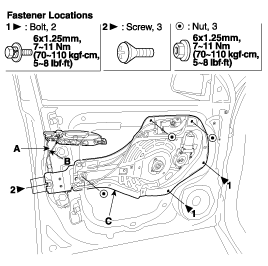
Installation is the reverse or removal.
Make sure the connectors is plugged in properly and each cable is connected securely.
Make sure the door locks and opens properly.
Roll the glass and down to see if it moves freely without binding.
Put on gloves to protect your hands.
Remove the following parts.
Door trim (See page BD- 25).
Glass trim (See page BD- 26).
Rear channel (See page BD- 26).
Disconnect the outside handle rod (A) and lock rod (B).
After removing the outside handle mouting bolt, remove the outside handle base (C) and key cylinder.
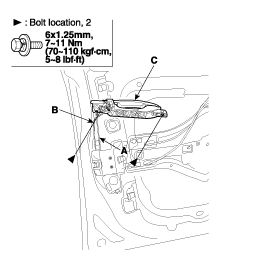
After removing the key cylinder (A) and outside handle base (B), remove the outside handle lever (C).
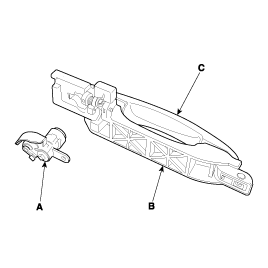
Installation is the reverse of removal.
Make sure the connector is plugged in properly, and each rod is connected securely.
Make sure the door locks and opens properly.
Remove the door trim (See page BD- 25)
Disconnect the speaker connector (A), and remove the speaker (B).

Installation is the reverse of removal.
Remove the front door trim (See page BD- 25).
Loosen the inside handle (A) mounting screw.
Push the inside handle forward to disconnect from the door module.
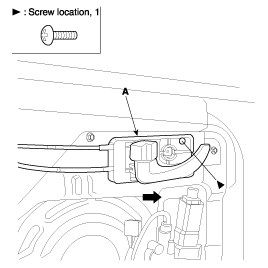
Disconnect the lock cable and (A) inside handle connect cable (B).
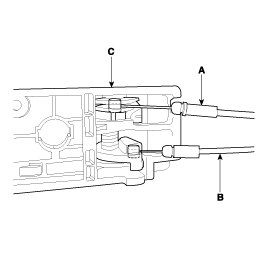
Installation is the reverse of removal
Make sure the door locks and opens properly.
Remove the front door trim (See page BD- 25).
Release the hooks (A), and then remove the door belt weatherstrip (B).

Installation is the reverse of removal.
Remove the front door trim (See page BD- 25).
Remove the glass (see page BD- 26).
Remove the glass run channel (A) from the lower part.
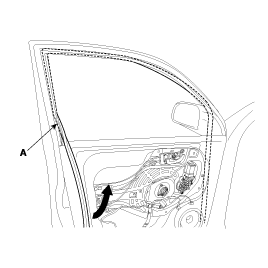
Installation is the reverse of removal.
Release the clips then remove the door weatherstrip (A).
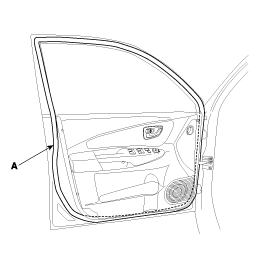
Installation is the reverse of removal.
Check the glass run channel for damage or deterioration, and replace them if necessary.
Remove the following parts:
Quadrant cover (See page BD- 57)
Door trim (See page BD- 25)
Carefully move the glass (A) until you can see the glass mounting bolts (B), then loosen them.
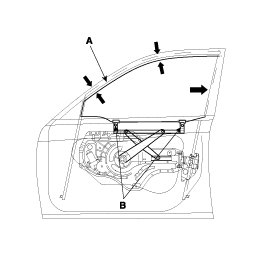

Push the glass (A) against the channel (C), then tighten the glass mounting bolts.
Check that the glass moves smoothly.
Raise the glass fully, and check for gaps. Check that the glass contacts the glass run channel evenly.
Check for water leaks. Run water over the roof and on the sealing area as shown, and note these items:
Use a 12mm (1/2in.)diameter hose (A).
Adjust the rate of water flow as shown (B).
Do not use a nozzle.
Hold the hose about 300mm (12in.) away from the door (C).
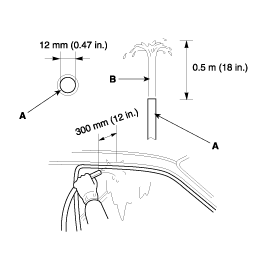
After installing the door, check for a flush fit with the body, then check for equal gaps between the front, rear, andbottom, door edges and the body. Check that the door and body edges are parallel. Before adjusting, replace the mounting bolts.
Place the vehicle on a firm, level surface when adjusting the doors.
Adjust at the hinges(A):
Loosen the door mounting bolts(B) slightly, and move the door IN or OUT until it’s flush with the body.
Loosen the hinge mounting bolts (C) slightly, and move the door BACKWARD or FORWARD, UP or DOWN as necessary to equalize the gaps.
Place a shop towel(D) on the jack(E) to prevent damage to the door when adjusting the door.

Check that the door and body edges are parallel.
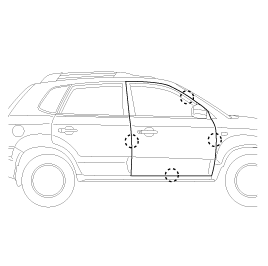
Grease the pivot portions of the hinges indicated by the arrows.
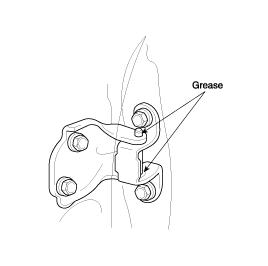
Check for water leaks (See page BD- 32).
Make sure the door latches securely without slamming it. If necessary, adjust the striker (A): The striker nuts are fixed. The striker can be fine adjusted up or down, and in or out.
Loosen the screws (B), then insert a shop towel between the body and striker.
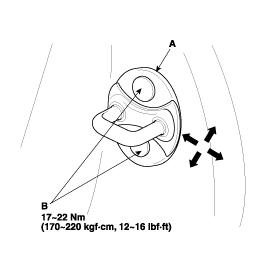
Lightly tighten the screws.
Wrap the striker with a shop towel, then adjust the striker by tapping it with a plastic hammer. Do not tap the striker too hard.
Loosen the screws and remove the shop towel.
Lightly tighten the screws.
Hold the outer handle out, and push the door against the body to be sure the striker allows a flush fit. If the door latches properly, tighten the screws and recheck.